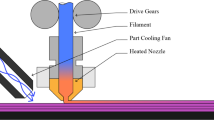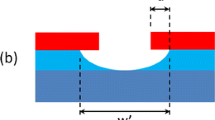Abstract
A novel multi-function stylus profiling system has been developed for characterizing surface properties at micro/nanometer scales. The multi-function stylus profiling system provides, within one set-up arrangement, measurements of topography, friction, Young’s modulus and hardness of a surface. The measurement is based on point-by-point scanning so that the four measured functions can be correlated in space and in time. It targets an area that is of growing importance to a wide range of technologies where function-orientated surfaces/coatings are in demand. The essential part of the multi-function stylus profiling system is a special sensing probe, which has an electromagnetic force actuator and three precision capacitive sensors for simultaneous measurements of surface height/deformation and friction force between the probe tip and the surface being scanned. The system provides a controllable loading force in a range of 0.05–20 mN. The topography measurement has a maximum range of 20 µm. The scanning area of 100 µm × 100 µm is closed-loop controlled with an accuracy of 1 nm. Design, analysis, and experimental investigation of the multi-function stylus profiling system are carried out. Evaluations are carried out on certain material surfaces to demonstrate the capability of the system.























Similar content being viewed by others
References
Asif SAS, Wahl KJ, Colton RJ (1999) Nanoindentation and contact stiffness measurement using force modulation with a capacitive load-displacement transducer. Rev Sci Instrum 70(5):2408–2413
Assender H, Bliznyuk V, Porfyrakis K (2002) How surface topography relates to materials’ properties. Science 297(5583):973–976
Barbour PSM, Stone MH, Fisher J (1999) A study of the wear resistance of three types of clinically applied UHMWPE for total replacement hip prostheses. Biomaterials 20(22):2101–2106
Borghi A, Gualtieri E, Marchetto D et al (2008) Tribological effects of surface texturing on nitriding steel for high-performance engine applications. Wear 265(7–8):1046–1051
Choi JH, Korach CS (2011) Tip bluntness transition measured with atomic force microscopy and the effect on hardness variation with depth in silicon dioxide nanoindentation. Int J Precis Eng Manuf 12(2):345–354
Doerner MF, Nix WD (1986) A method for interpreting the data from depth-sensing indentation instruments. J Mater Res 1(4):601–609
Du X, Zhao H, Zhang L et al (2015) Molecular dynamics investigations of mechanical behaviours in monocrystalline silicon due to nanoindentation at cryogenic temperatures and room temperature. Sci Rep 5:16275
Gao P, Yuan Z (1999) Development of a micromechanical probe-measuring instrument for surface properties characterization. Meas Sci Technol 10(8):105–108
Herrmann K, Jennett NM, Wegener W et al (2000) Progress in determination of the area function of indenters used for nanoindentation. Thin Solid Films 377–378(1–2):394–400
Herzig HP (1997) Micro-optics: elements, systems and applications. Taylor and Francis, London
Heuberger M, Dietler G, Schlabach L (1995) Mapping the local Young’s modulus by analysis of the elastic deformations occurring in atomic force microscopy. Nanotechnology 6(1):12–23
Hollander AE, Lancaster JK (1973) An application of topographical analysis to the wear of polymers. Wear 25(2):155–170
Houston JE, Michalske TA (1992) The interfacial-force microscope. Nature 356:266–267
Kulkarni AV, Bhushan B (1996) Nanoscale mechanical property measurements using modified atomic force microscopy. Thin Solid Films 290–291:206–210
Liu X (2013) Correlation analysis of surface topography and its mechanical properties at micro and nanometre scales. Wear 305(1–2):305–311
Liu X, Gao F (2003) A novel multi-function tribological probe microscope for mapping surface properties. Meas Sci Technol 15(1):91–102
Liu X, Bell T, Chetwynd DG et al (2003) Characterisation of engineered surfaces by a novel four-in-one tribological probe microscope. Wear 255(1–6):385–394
Mate CM, McClelland GM, Erlanfsson R et al (1987) Atomic-scale friction of a tungsten tip on a graphite surface. Phys Rev Lett 59(17):1942–1945
Oliver WC, Pharr GM (1992) An improved technique for determining hardness and elastic modulus using load and displacement sensing indentation experiments. J Mater Res 7(6):1564–1583
Oliver WC, Pharr GM (2004) Measurement of hardness and elastic modulus by instrumented indentation: advances in understanding and refinements to methodology. J Mater Res 19(1):3–20
Pharr GM (1998) Measurement of mechanical properties by ultra-low load indentation. Mater Sci Eng A 253(1–2):151–159
Raguin DH, Morris GM (1993) Antireflection structured surfaces for the infrared spectral region. Appl Opt 32(7):1154–1167
Saha R, Nix WD (2002) Effects of the substrate on the determination of thin film mechanical properties by nanoindentation. Acta Mater 50(1):23–38
Saunders SRJ, Vetters HR (1997) Standardisation of test methods for the mechanical properties of thin coatings. Thin Solid Films 299(1–2):82–87
Spori DM, Drobek T, Zürcher S et al (2008) Beyond the lotus effect: roughness influences on wetting over a wide surface-energy range. Langmuir 24(10):5411–5417
Tian J, Tian Y, Guo Z et al (2016) Development of a novel 3-DOF suspension mechanism for multi-function stylus profiling systems. Int J Precis Eng Manuf 17(11):1415–1423
Wang X, Zhu JY, Chen W et al (2007) Influence of micro-patterned laser surface texturing on the tribological performance. Int J Comput Appl Technol 29(2–4):114–119
Whitehouse DJ (1994) Handbook of surface metrology. Institute of Physics Publishing, Bristol
Yu N, Bonin WA, Polycarpou AA (2005) High-resolution capacitive load-displacement transducer and its application in nanoindentation and adhesion force measurements. Rev Sci Instrum 76(4):045109
Zhou L, Kato K, Vurens G et al (2003) The effect of slider surface texture on flyability and lubricant migration under near contact conditions. Tribol Int 36(4–6):269–277
Acknowledgements
This research is supported by National Natural Science Foundation of China (nos. 51675371, 51675367 51405333, 51420105007), EU H2020 MSCA RISE 2016 (no. 734174).
Author information
Authors and Affiliations
Corresponding author
Rights and permissions
About this article
Cite this article
Tian, J., Tian, Y., Guo, Z. et al. Structure design and experimental investigation of a multi-function stylus profiling system for characterization of engineering surfaces at micro/nano scales. Microsyst Technol 24, 2177–2187 (2018). https://doi.org/10.1007/s00542-018-3794-5
Received:
Accepted:
Published:
Issue Date:
DOI: https://doi.org/10.1007/s00542-018-3794-5




